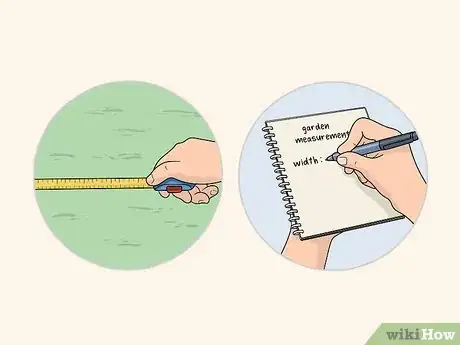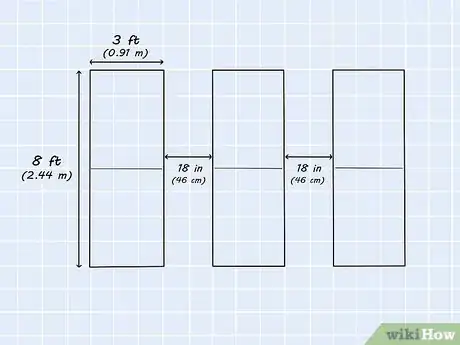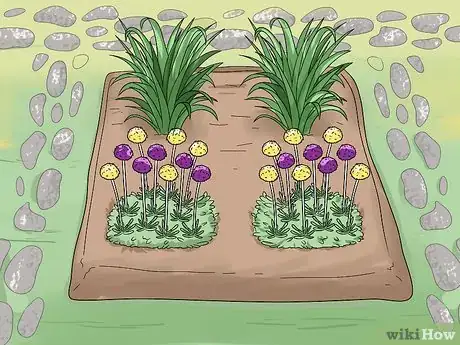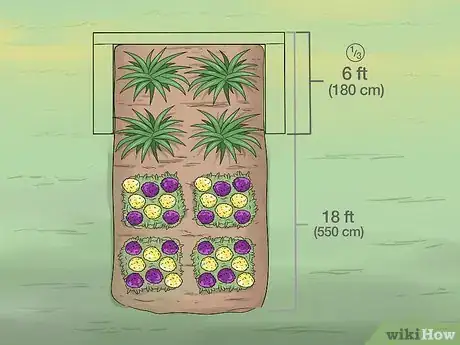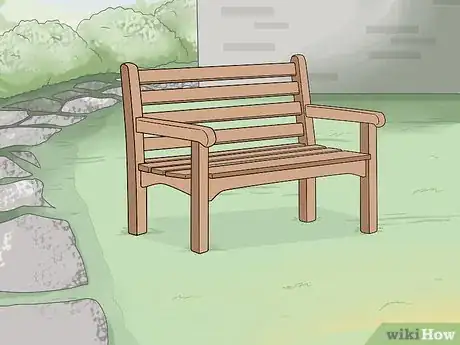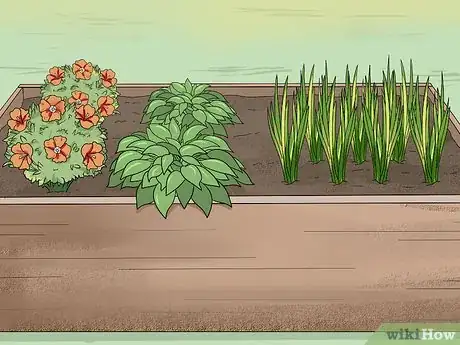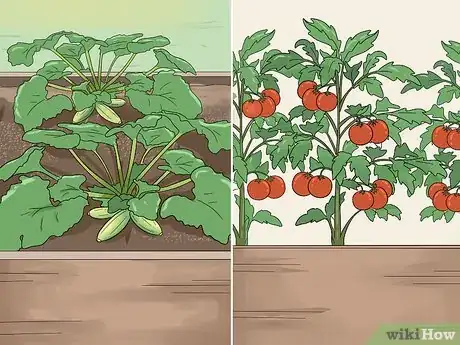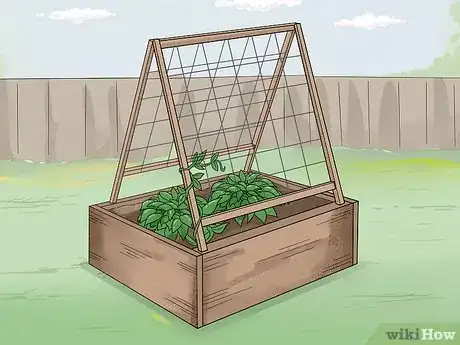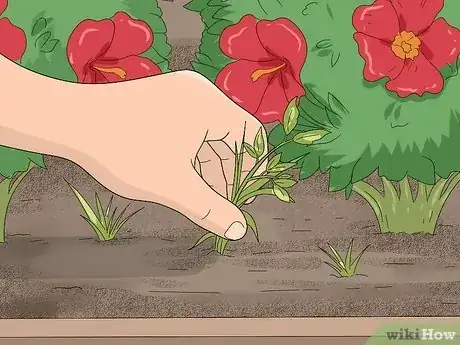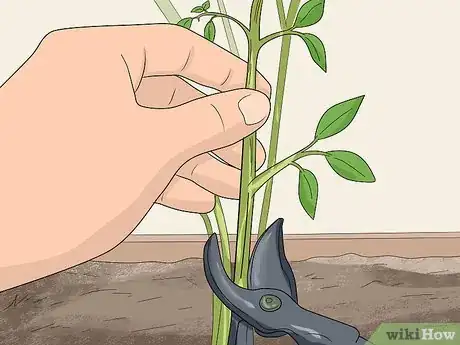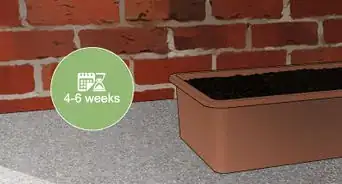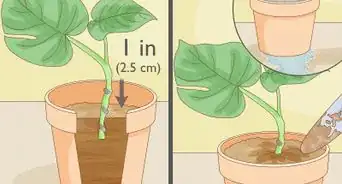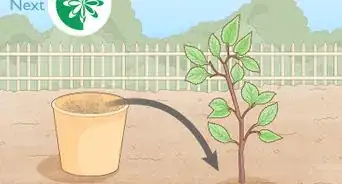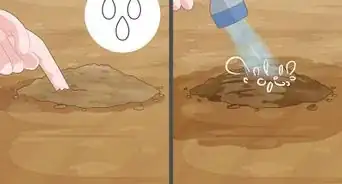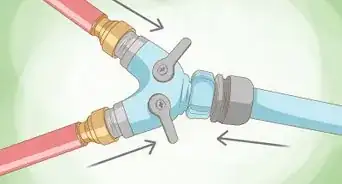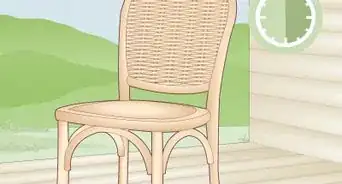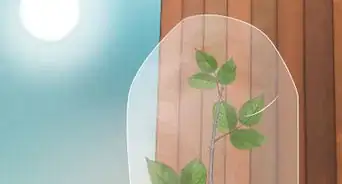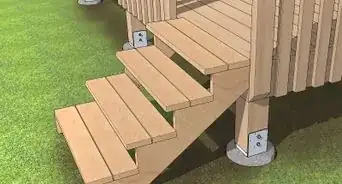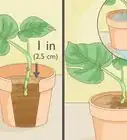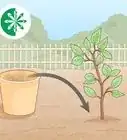This article was co-authored by Steve Masley and by wikiHow staff writer, Hunter Rising. Steve Masley has been designing and maintaining organic vegetable gardens in the San Francisco Bay Area for over 30 years. He is an Organic Gardening Consultant and Founder of Grow-It-Organically, a website that teaches clients and students the ins and outs of organic vegetable gardening. In 2007 and 2008, Steve taught the Local Sustainable Agriculture Field Practicum at Stanford University.
There are 19 references cited in this article, which can be found at the bottom of the page.
This article has been viewed 55,768 times.
Even if you don’t have a large area in your yard, you can still make a beautiful garden that maximizes the space you have. Before you begin digging or planting, make sure you have a detailed plan for the layout of your garden and the plants you want to include. Look for plants that grow well in your area and are small enough to fit in your garden when they reach their full size. With the right plants, you'll only have around 1 hour of weekly upkeep for your small garden.
Steps
Choosing the Best Location
-
1Choose an area that gets 6–8 hours of sun daily. Since most flowering plants and vegetables require full sun to grow properly, opt for the sunniest area in your yard to place your garden. If the area doesn’t get a lot of light during the day, you may still be able to grow plants that thrive in the shade.[1]
- Plants that don’t receive enough light won’t produce as many blooms or grow as well.
-
2Pick a spot that’s close to a water source. Try to find an area that either has a natural water source or sits close to your outdoor hose attachment. That way, the soil will stay moist and make it less likely to dry out and kill your plants. If you aren’t able to place your garden directly by a water source, make sure it’s as close as possible.[2]
- You can also try building an artificial pond or water feature if you want to help keep the soil hydrated.
Advertisement -
3Opt for a place where you can easily access your garden. Look for a place in your yard where you can see your garden from a window or a spot in your yard so you’re able to enjoy it. Make sure you can walk into your garden with ease to make it easier to take care of your plants. Avoid placing it anywhere that’s difficult to get to, or else it may become more of a hassle.[3]
-
4Measure the space you have available for your garden. Stretch a measuring tape across the length of the area, and record the measurement on a piece of paper. Then take the measurement for the width of the area. Double-check your measurements to make sure they’re accurate so you can plan the space efficiently.[4]
- Typically, plots grow best in rectangular areas, but you can make your garden a different shape, such as a triangle or circle, if it fits the space better.
Tip: Put wooden stakes around the perimeter of the area and stretch twine between them to help you visualize the size of the space better.
Following Design Principles
-
1Plan the layout for your garden to scale on a piece of graph paper. Draw the outline on the paper so each grid square equals 1⁄2 or 1 square foot (0.046 or 0.093 m2). Start by sketching longer rectangles for your garden beds so they’re to scale for the actual size you want them. Then divide the rectangles into smaller sections for each different plant you want to put in them, assuming that 1–2 plants usually take up 1 square foot (0.093 m2). Be sure to leave a 18 in (46 cm) space between garden beds so you can easily walk between them and care for your plants.[5]
- For example, if you want a garden bed that’s 3 by 8 feet (0.91 m × 2.44 m) and each square on the graph paper equals 1 square foot (0.093 m2), then you would draw a rectangle that’s 3 squares tall by 8 squares long. This bed would leave enough room for 24–48 plants.
- Work in pencil so you can erase and make changes to the design easily.
- Look online for digital garden planners to help you design the layout.
-
2Use square-foot gardening for the most compact growing system. Make a grid on your design so each square is 1 by 1 feet (30 cm × 30 cm). Make a list of the plants you want to grow and label each square on the grid with one of the plants from your list. Make sure you know the final growing sizes so you can easily manage how many plants of a species you’ll be able to grow in the square.[6]
- Typically, you can fit 1–2 individual plants of a species in 1 square foot (0.093 m2) area, but you may be able to plant more if they’re small growths. Talk to an employee at a gardening center since they can help you choose plants that will work the best.
-
3Arrange your design so there are focal points. Aim to have 1–2 aspects of your garden design unique so they stand out from the rest of your plants. This could be a statue, fountain, or small tree placed in the center or on either side. Take into consideration where you want people to focus or have their attention drawn to when they look at your garden, and plan your design around those spots.[7]
- Focal points help your garden feel more inviting and make them more visually pleasing.
- Paths in your garden can also help draw people’s eyes in certain directions to help then flow visually.
-
4Put similar plants across from one another to create rhythm and symmetry. Rather than putting different plants in each of your garden beds, opt for using the same plant or ones that have similar textures or colors so they’re across from one another. That way, when you look at your garden, it will look inviting and make the area feel more balanced. Make sure the plants on each side of your garden have approximately the same sizes, or your garden design may look messy or unbalanced.[8]
-
5Make the edge height ⅓ of the horizontal length to help it feel enclosed. Making your garden feel enclosed will make you feel more comfortable while you’re working in your garden. Measure the horizontal length of the garden area and opt for plants or design features that are at least a third of that length in your design.[9]
- For example, if you have a garden that’s 18 feet (550 cm) long, aim to have plants that reach up to 6 feet (180 cm) around the edges
-
6Include room for seating in your design if you want a place to relax. Look online or at gardening stores to find outdoor seating that fits your space and matches your style. Draw the seating in your design, and make sure you have paths that lead to it. You can place the seating directly in the grass, or you can set it on tiles or pavers for a flat, even surface.[10]
- Avoid using furniture made for indoor use since it could easily develop mold or get dirty from the weather.
- You don’t need to include seating in your garden if you don’t have the space.
Selecting Your Plants
-
1Opt for raised beds that are 12 in (30 cm) deep for better soil. Look for raised beds or containers that are around 4 feet (1.2 m) wide and 12 inches (30 cm) deep so the plant roots have room to grow. Avoid getting beds any wider since it can make it more difficult to care for and harvest your plants. If possible, orient the beds so they run from north to south to allow your plants to get the most amount of light during the day.[11]
- If you don’t want to use raised beds, you can still plant in rows directly in the ground.
- Build the planting beds if you aren’t able to find preconstructed ones in the sizes you need.
- You can make your own beds for cheap using plywood.[12]
-
2Mix ornamental and edible plants together in your garden. Try to include at least 1–2 types of flowering ornamental plants in each of your garden beds where you plan on growing vegetables. Opt for plants that have different leaf shapes and a variety of blooms to make your garden look visually interesting. Talk to the employees at a local gardening center to find out what plants are the most compatible so they don’t compete for nutrients.[13]
- Some ornamental plants you can use in your garden include hostas, hibiscus, allium, salvia, lavender, and sedum.[14]
- Flowering ornamental plants also attract beneficial insects that kill other pests and help pollinate.
- You don’t need to include vegetables in your garden if you only want ornamental or flowering plants.
-
3Choose compact varieties of plants to maximize the space. If you like the look of larger plants and want to grow them, check your local gardening center to see if they have compact versions of them. Check the final growing size on the packaging to make sure they’ll still properly fit in your garden beds at the end of the season. Include the plants in your garden design drawing so you see how much space they’ll take up.[15]
- The most common vegetables that have compact varieties are cucumbers, tomatoes, zucchini, and squash, but you may be able to find others.
- Avoid planting anything melons or fruit trees, since they can be difficult to control and can steal nutrients from other plants.
-
4Use companion planting to reduce competition for nutrients and manage pests. Talk to an employee at a gardening center or look online about the plants you want to grow and what pairs well with them. Try to position smaller plants in between larger ones so you can make the most of the growing space. Make sure the plants you select are compatible with one another, or else they may not grow to their full potential.[16]
Companion Plant Examples:
· Tomatoes grow well with dill and basil since they protect against pests.
· Marigolds pair with most garden vegetables and protect them from nematodes.
· Try rosemary or sage next to broccoli, kale, or turnips.
· Use nasturtiums to attract aphids away from other plants in your garden.
· Garlic and onions can deter pests, but they will affect the growth of beans or peas. -
5Include a fence or trellis to help plants grow vertically. Try to put the trellis or fence along the north side of your garden so plants growing on it can get the most light throughout the day. Aim to have a 5–6 feet (1.5–1.8 m) tall trellis to help it support the most growth.[17] Avoid placing a trellis or fence where it casts shade on other plants, or else you could make them grow less efficiently.[18]
- Trellises and fences work well for plants vine-like plants, such as peas, beans, squashes, and tomatoes.
- You may also attach shelves or containers directly to a fence if you want to grow flowering plants off of the ground.
-
6Try succession planting if you want a large variety of vegetation. Look for plants that stop blooming or are ready to harvest in the middle of the growing season. Then choose varieties of plants that thrive in the latter half of the growing season to replace the plants that grew earlier. That way, your garden will always produce fresh vegetables or blooms throughout the entire year.[19]
- For example, you can plant radishes or lettuce in the spring to harvest in the late summer. Then you may grow summer squash in the same location to harvest in the fall.[20]
Tending Your Garden
-
1Mulch between your plants to help the soil retain water. Aim to have a 2–3 in (5.1–7.6 cm) layer of organic mulch, such as wood chips, leaves, or peat moss. Spread the mulch evenly across your garden so it’s about 2 inches (5.1 cm) away from any of your plants’ stems. Reapply mulch throughout the season if you notice it getting thin.[21]
- Mulch also prevents weeds from growing in your garden beds.
-
2Water the soil when it feels dry 3 in (7.6 cm) below the surface. Dig a hole in the soil that’s 2 inches (5.1 cm) deep and touch it with your finger. If it feels dry, use a watering can or a hose to water the soil until it’s wet 6–8 inches (15–20 cm) deep. Check the soil daily to make sure it doesn’t dry out and kill your plants.[22]
- Plants in containers or raised beds usually need to be watered more often than those directly planted in the ground.
-
3Apply fertilizer in the beginning and middle of the growing season. You can either use liquid fertilizer or buy granules that soak into the soil. Apply half of the fertilizer amount on the soil near your plants and spread it evenly throughout the garden bed. Immediately water the soil so the fertilizer can soak in and give nutrients to your plants.[23]
- Be careful not to get any fertilizer directly on your plants since you could damage them.
-
4Pull weeds out by hand when you see them growing. Check your garden beds weekly for weeds growing between your plants. Grab the weeds as close to the soil as you can and pull them straight out of the ground. If you don’t want to pull them by hand, use a hoe or trowel to dig out the roots and remove them from your garden.[24]
- Avoid leaving the weed’s roots in the soil since they could grow back.
Warning: Avoid using chemical weed killers since they could also harm or kill other plants you have in your garden.
-
5Prune plants to control their sizes.[25] Begin pruning at the start of the season to help promote new growth, and in the middle of the season to help keep your garden looking clean. Remove any stems or branches that have damage or look leggy with a pair of hand pruners. Make cuts at a 45-degree angle to help reduce the chance of rot.[26]
- Don’t cut off any more than a third of the vegetation, or else the plant may not grow back as easily.
Expert Q&A
-
QuestionWhat is the best way to plant a small garden?
 Steve MasleySteve Masley has been designing and maintaining organic vegetable gardens in the San Francisco Bay Area for over 30 years. He is an Organic Gardening Consultant and Founder of Grow-It-Organically, a website that teaches clients and students the ins and outs of organic vegetable gardening. In 2007 and 2008, Steve taught the Local Sustainable Agriculture Field Practicum at Stanford University.
Steve MasleySteve Masley has been designing and maintaining organic vegetable gardens in the San Francisco Bay Area for over 30 years. He is an Organic Gardening Consultant and Founder of Grow-It-Organically, a website that teaches clients and students the ins and outs of organic vegetable gardening. In 2007 and 2008, Steve taught the Local Sustainable Agriculture Field Practicum at Stanford University.
Home & Garden Specialist Raised beds are easier to manage since you can more easily control the soil and nutrients inside the container. You also never have to walk on the soil. As a precaution, make sure you have room to access the bed on all sides.
Raised beds are easier to manage since you can more easily control the soil and nutrients inside the container. You also never have to walk on the soil. As a precaution, make sure you have room to access the bed on all sides. -
QuestionMy black raspberries have stunted leaves and fruit is small and seedy. Any advice?
 bear berryhillCommunity AnswerIt is most likely a fungal attack, or some sort of disease, the soil is most likely contaminated, and had some dormant disease that the plants activated, dig up the soil, and let it heat up and dry, that should deal with the blight.
bear berryhillCommunity AnswerIt is most likely a fungal attack, or some sort of disease, the soil is most likely contaminated, and had some dormant disease that the plants activated, dig up the soil, and let it heat up and dry, that should deal with the blight. -
QuestionIs planting plants in a raised bed better than planting them in the ground?
 bear berryhillCommunity AnswerIt depends on the soil, and how often you feel comfortable with watering. In my experience, planting in the ground is better, but you might want to test your soil, and modify it if necessary. Both methods have their ups and downs.
bear berryhillCommunity AnswerIt depends on the soil, and how often you feel comfortable with watering. In my experience, planting in the ground is better, but you might want to test your soil, and modify it if necessary. Both methods have their ups and downs.
Things You’ll Need
- Tape measure
- Graph paper
- Raised garden beds
- Fencing or trellis
- Outdoor seating (optional)
- Watering can or hose
- Mulch
- Fertilizer
- Hand pruners
- Seeds/Mini plants
References
- ↑ https://www.bobvila.com/articles/2500-how-to-plant-a-vegetable-garden/
- ↑ https://extension.uga.edu/publications/detail.html?number=C1027-11&title=Sources%20of%20Water%20for%20the%20Garden
- ↑ https://www.gardeners.com/how-to/garden-design-basics/5165.html
- ↑ https://agrilifeextension.tamu.edu/library/gardening/planning-a-garden/
- ↑ https://agrilifeextension.tamu.edu/library/gardening/planning-a-garden/
- ↑ https://www.almanac.com/video/planning-square-foot-garden
- ↑ https://www.gardeners.com/how-to/garden-design-basics/5165.html
- ↑ https://www.gardeners.com/how-to/garden-design-basics/5165.html
- ↑ https://www.gardendesign.com/landscape-design/rules.html
- ↑ https://youtu.be/U-iyod0unLM?t=312
- ↑ https://www.almanac.com/content/how-build-raised-garden-bed
- ↑ Steve Masley. Home & Garden Specialist. Expert Interview. 20 March 2019.
- ↑ https://youtu.be/U-iyod0unLM?t=128
- ↑ http://www.perennialresource.com/photo_essay.php?ID=292
- ↑ https://www.gardeningchannel.com/small-vegetable-garden-layout-ideas/
- ↑ https://www.almanac.com/content/raised-bed-gardens-and-small-plots
- ↑ https://extension.umn.edu/planting-and-growing-guides/trellises-and-cages#stakes-821161
- ↑ https://www.almanac.com/content/small-vegetable-garden-plans-and-layouts#
- ↑ https://www.almanac.com/content/small-vegetable-garden-plans-and-layouts#
- ↑ https://www.gardeningchannel.com/small-vegetable-garden-layout-ideas/
- ↑ https://extension.umd.edu/hgic/topics/caring-your-garden
- ↑ https://garden.org/learn/articles/view/1284/
- ↑ https://extension.umd.edu/hgic/topics/caring-your-garden
- ↑ https://garden.org/learn/articles/view/1284/
- ↑ Steve Masley. Home & Garden Specialist. Expert Interview. 20 March 2019.
- ↑ https://www.thisoldhouse.com/ideas/shrub-pruning-dos-and-donts



